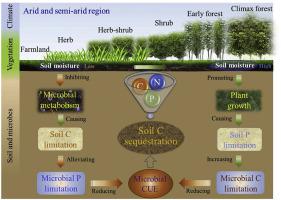Soil Biology and Biochemistry ( IF 9.8 ) Pub Date : 2020-05-01 , DOI: 10.1016/j.soilbio.2020.107814 Yongxing Cui , Xia Wang , Xingchang Zhang , Wenliang Ju , Chengjiao Duan , Xiaobin Guo , Yunqiang Wang , Linchuan Fang

|
Revegetation of semiarid lands depends upon soil microbial communities to supply nutrients for successive plant species, but microbial activity can be constrained by insufficient water. The objective of this study was to quantify the metabolic limitation of microbes by extracellular enzymatic stoichiometry, and to determine how this affected microbial carbon use efficiency (CUE) with biogeochemical equilibrium model. The study occurred in long-term revegetation experiment with seven successional stages (0, 11, 35, 60, 100, 130 and 150 years) in the Loess Plateau, China. Microbes maintained stoichiometric homeostasis in all successional stages, but plants did not. Microbial metabolism was limited by low soil phosphorus (P) concentration throughout the succession, whereas plants were limited by low soil P during the late successional stages (from 60 to 150 years) only. An increase in soil moisture during succession was associated with greater P limitation in microbes and plants. There was less microbial P limitation at the 35-year successional stage, and the greatest microbial P limitation occurred at the 130-year successional stage. The microbial C limitation followed a unimodal pattern through the vegetation succession and reached a maximum at 100 years of succession (the early forest stage). This coincided with the lowest microbial CUE at 100 years of succession (CUE was from 0.24 to 0.41), suggesting a change in the physiological responses from microbes (such as enzyme synthesis and the priming effect), that tended to reduce soil C sequestration. Our results indicate that soil moisture regulated microbial C and P metabolism during the vegetation succession in this semiarid region, which has implications for understanding how microbial metabolism affects soil C dynamics under vegetation restoration.


















































 京公网安备 11010802027423号
京公网安备 11010802027423号